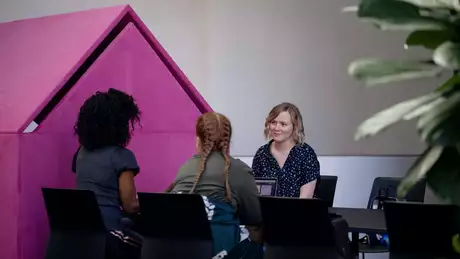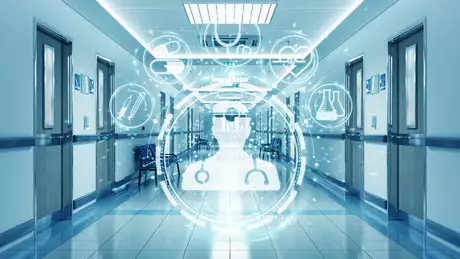
Thomas Hellstén, PhD student, Senior Lecturer in Physiotherapy, Department of Health and Welfare, Arcada, E-mail: thomas.hellsten
Jonny Karlsson, PhD, Senior Lecturer in Information Technology, Degree Programme Director, Department of Business Management and Analytics, Arcada
Jyrki Kettunen, PhD, Docent, Physiotherapist, Department of Health and Welfare, Arcada
The ongoing COVID-19 pandemic has increased the use of telerehabilitation (TR) in the daily work of physiotherapists and forced health care organisations to implement new ways to be in contact with rehabilitees (Werneke et al., 2021, Seron et al., 2021). TR is a field of telehealth and can be defined as delivery of rehabilitation at a distance, using information and communication technology (ICT) (Cox et al., 2021). TR can be used synchronously, where the physiotherapist and rehabilitee are physically in different places and communicate in real time through ICT (e.g. videoconference). It can also be used asynchronously, where ICT technology transfers automatic feedback and support for the rehabilitee (Capecci et al., 2018). For rehabilitees TR may provide easier access to health care services e.g. for those who find travelling difficult due to their health. TR can favour rehabilitees who are geographically or socially isolated and rehabilitees in working life with hectic timetables, which reduce rehabilitees ability to access physiotherapy (Seidman et al., 2017). During the COVID-19 pandemic, TR has supported government policy in promoting individual’s isolation in the effort to decrease the spread of COVID-19 (Cottrell, Russell, 2020). As a consequence of this, the use of TR has increased, e.g. in Switzerland with almost 40% (Rausch et al., 2021). It has also been stated that TR could become a common method in physiotherapy in the future (Seron et al., 2021).
Assessment in telerehabilitation
In physiotherapeutic assessment the purpose is to monitor, evaluate and describe the functionality of a rehabilitee, so that it can be used as the basis for the physiotherapy process and the clinical reasoning. In physiotherapy the key methods for assessment are interview, observation, manual examination and measurement (Hynynen et al., 2016). To our knowledge, physiotherapists experience clinical measurements and examinations as challenging at distance with the methods in TR, e.g. joint range of motion and muscle strength testing. Physiotherapy has traditionally been a profession where professionals have been able to manually touch, facilitate and asses the rehabilitee. With palpation a physiotherapist can assess e.g. pain, sensation, swellings and muscle joint and nerve function (Hynynen et al., 2016), and TR brings variations in these practises (Sharma, Clarke, 2014).
There are different methods and models implemented in TR (Seron et al., 2021). In clinical work, a synchronous method is what physiotherapists primarily use for communication and assessment, and the technology solution is videoconference. Employing an asynchronous method (e.g. activity trackers or smart clothes), or using both modes, is currently not that common (Werneke et al., 2021). Technology that are often used in TR are telephone, videophone, smartphone and computer, but also sensors, virtual reality and robotics. Despite increasing development and implementation of TR technology, these technologies have been evaluated without carefully considering the usability among rehabilitees (Niknejad et al., 2021). TR is mostly used within the core area of physiotherapy, e.g. therapeutic exercise and physiotherapeutic council (Seron et al., 2021).
Computer vision
Two years ago, Arcada started an interdisciplinary research project in the field of TR involving physiotherapy and information technology disciplines. In this project the two disciplines develop a computer vision (CV)-based markerless motion detection system in collaboration with students, lecturers and researchers, but also with companies and partner universities.
The rapid growth of health technology requires new skills among professionals in health care, engineering and business (Ahonen et al., 2017). In a development process like this, well-coordinated and working interdisciplinary teams are productive; professionals from different sectors can point out the benefits and barriers in development, implementation, evaluation and the use in practice. As a guideline within the project, the interdisciplinary research team at Arcada has used the CeHRes Roadmap, which consists of five intertwined phases; solution for a relevant issue, development, design, actions for introducing the technology in intended context, and evaluation (Kelders et al., 2018).
CV is a novel technology that can be used e.g. in assessment in physiotherapy. CV applications can range from automatic rehabilitation aids giving real time feedback and instruction to rehabilitees performing therapeutic exercises to software analysing e.g. joint range of motion. Traditionally CV-based solutions for motion analysis have involved installation of markers on different parts of the rehabilitee’s body. These motion analysis applications have been dependent on costly laboratory equipment and the professional’s competence in laboratory work. A more practical solution for a physiotherapist is a CV-based markerless motion detection system that is technically easy to use. However, collecting accurate motion data without the use of markers is a challenge from a technical point of view.
In this project the research group has started to develop a CV-based markerless solution for measuring the knee joint angle that fulfils the standards detailed by physiotherapists. At the outset, the requirement has been a maximum error tolerance of ± 5 degrees in the measurement of a rehabilitee’s knee joint range of motion, and the application must work on a standard laptop with a standard web camera.
The technical and clinical performance of the prototype has been tested for certain knee angles (0°, 60°, 90°, 120°) and in functional movements. Preliminary tests with healthy young persons, indicate that the latest protype version is able to fulfil the measurement requirements in upright position. However, the prototype version still needs to be rigorously tested by physiotherapy students under standardized conditions used for testing.
Critical analysis of the benefits and barriers is still needed before CV-based markerless motion analysis solutions can be implemented in physiotherapy. To fulfil this, a strong interdisciplinary collaboration among students, teachers, researchers, and professionals from different disciplines is required.
Acknowledgements
We wish to thank Mr. Jan-Anders Ray, for the final correction of the language of the blog text.
References
Ahonen, O., Rajalahti, E., Tana, J., Lejonqvist, G., Kinnunen, U. & Saranto, K. 2017, “Developing digital health and welfare services in an international multidisciplinary student team” in MEDINFO 2017: Precision Healthcare through Informatics IOS Press, pp. 679-683.
Capecci, M., Ceravolo, M.G., Ferracuti, F., Iarlori, S., Kyrki, V., Monteriù, A., Romeo, L. & Verdini, F. 2018, “A Hidden Semi-Markov Model based approach for rehabilitation exercise assessment”, Journal of Biomedical Informatics; J Biomed Inform, vol. 78, pp. 1-11.
Cottrell, M.A. & Russell, T.G. 2020, “Telehealth for musculoskeletal physiotherapy”, Musculoskeletal Science and Practice, vol. 48, pp. 102.
Cox, N.S., Dal Corso, S., Hansen, H., McDonald, C.F., Hill, C.J., Zanaboni, P., Alison, J.A., O’Halloran, P., Macdonald, H. & Holland, A.E. 2021, “Telerehabilitation for chronic respiratory disease”, Cochrane library, vol. 2021, no. 1.
Hynynen, P., Häkkinen, H., Hännikäinen, H., Kangasperko, M., Karihtala, T., Keskinen, M., Leskelä, J., Liikka, S., Lähteenmäki, M., Mämmelä, E., Partia, R., Piirainen, A., Sjögren, T. & Suhonen, L. 2016, The corecompetences of a physiotherapist, Suomen Fysioterapeutit.
Kelders, S.M., Lisette van Gemert-Pijnen, Sanderman, R. & Kip, H. 2018, eHealth Research, Theory and Development: A Multi-Disciplinary Approach, Taylor and Francis, Milton.
Niknejad, N., Ismail, W., Bahari, M. & Nazari, B. 2021, “Understanding Telerehabilitation Technology to Evaluate Stakeholders’ Adoption of Telerehabilitation Services: A Systematic Literature Review and Directions for Further Research”, Archives of Physical Medicine and Rehabilitation; Arch Phys Med Rehabil, vol. 102, no. 7, pp. 1390-1403.
Rausch, A., Baur, H., Reicherzer, L., Wirz, M., Keller, F., Opsommer, E., Schoeb, V., Vercelli, S. & Barbero, M. 2021, “Physiotherapists’ use and perceptions of digital remote physiotherapy during COVID-19 lockdown in Switzerland: an online cross-sectional survey”, Archives of physiotherapy, vol. 11, no. 1, pp. 18.
Seidman, Z., McNamara, R., Wootton, S., Leung, R., Spencer, L., Dale, M., Dennis, S. & McKeough, Z. 2017, “People attending pulmonary rehabilitation demonstrate a substantial engagement with technology and willingness to use telerehabilitation: a survey”, Journal of physiotherapy; J Physiother, vol. 63, no. 3, pp. 175-181.
Seron, P., Oliveros, M., Gutierrez-Arias, R., Fuentes-Aspe, R., Torres-Castro, R.C., Merino-Osorio, C., Nahuelhual, P., Inostroza, J., Jalil, Y., Solano, R., Marzuca-Nassr, G.N., Aguilera-Eguía, R., Lavados-Romo, P., Soto-Rodríguez, F.J., Sabelle, C., Villarroel-Silva, G., Gomolán, P., Huaiquilaf, S. & Sanchez, P. 2021, “Effectiveness of Telerehabilitation in Physical Therapy: A Rapid Overview”, Physical Therapy, vol. 101, no. 6, pp. 53.
Sharma, U. & Clarke, M. 2014, “Nurses’ and community support workers’ experience of telehealth: a longitudinal case study”, BMC health services research; BMC Health Serv Res, vol. 14, no. 1, pp. 164.
Werneke, M.W., Deutscher, D., Grigsby, D., Tucker, C.A., Mioduski, J.E. & Hayes, D. 2021, “Telerehabilitation During the COVID-19 Pandemic in Outpatient Rehabilitation Settings: A Descriptive Study”, Physical Therapy, vol. 101, no. 7, pp. 110.


